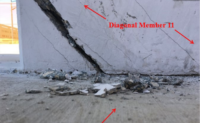Detailed inspections of the closed Roosevelt Bridge in Stuart, Fla., have revealed severe corrosion and ruptured steel reinforcing tendons in the southernmost portion of the 23-year old bridge’s southbound span. The Florida Dept. of Transportation reports that it is working on installing temporary supports beneath the affected section “out of an abundance of caution.”
A biannual inspection of the 4,566-ft-long segmental box girder bridge reveled cracks in that portion of the 62-ft-wide southbound span on June 16, according to FDOT. Overnight reports of fallen concrete from the underside of the span led FDOT to shift all traffic onto the twin northbound span. After cracks were discovered in that structure as well, FDOT closed the entire bridge and an underlying highway and initiated a full structural safety analysis.
Inspectors from the agency’s State Material Office used ground-penetrating radar, selective drilling, and interior and exterior visual and sounding inspections of both spans to search for other potential areas of corrosion. No further structural issues have been reported. The agency says the temporary supports will allow the underlying highway to be reopened while interior repairs to the Roosevelt Bridge proceed. No timeline has been announced for completion of the structural analysis or repair work.
Concerns about the bridge’s safety were heightened during the day on June 17 as a result of a U.S. Coast Guard warning that the structure was at risk of “imminent collapse.” Local officials said there was no such danger, but had yet to receive an explanation from the Coast Guard or FDOT for the apparently unsubstantiated alert. The channel beneath the bridge was briefly closed earlier in the day, but later reopened to commercial and recreational boat traffic.
Completed in 1997 at a cost of $54.7 million, the Roosevelt Bridge was given a 97.8 rating during FDOT’s 2018 inspection. According to Condotte-America, successor to bridge contractor Recchie America Inc., the 1,112 precast single-cell girder segments were erected with balanced cantilevers, using an overhead self-launching truss. Foundations were constructed with 30-inch square concrete piles, while the substructure consists of mass concrete footings, rectangular columns and flared pier caps.
Lead design firm LoBuono, Armstrong and Associates of Tallahassee, Fla., was acquired by Frederic R. Harris prior to the latter’s joining in the formation of AECOM
Updated 6/18/2020





